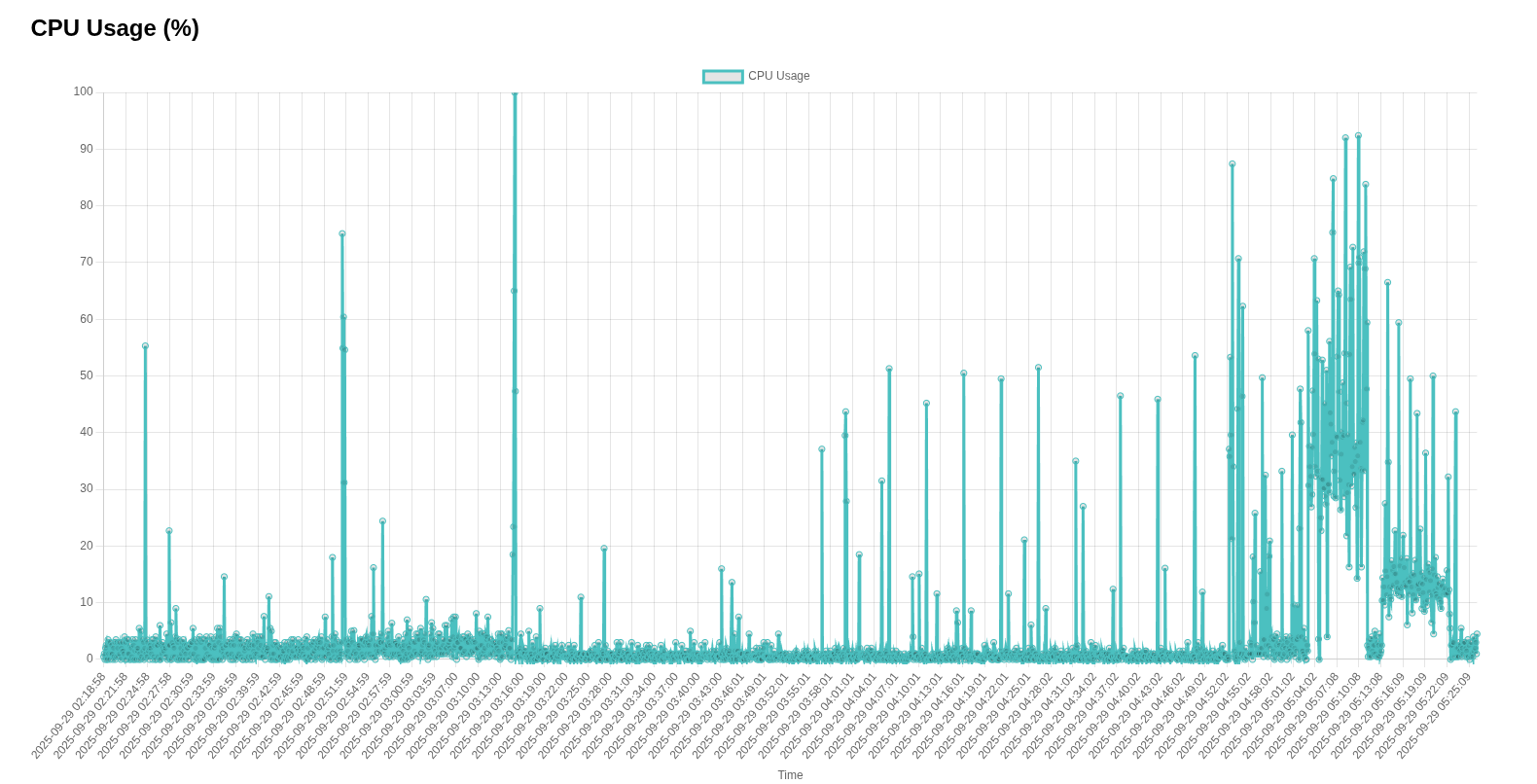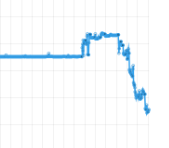VPS Monitor. Build a Small CPU / Disk / Ram / Network Monitor
VPS Monitor. Build a Small CPU / Disk / Ram / Network Monitor

It makes very nice and very clean graphs. We can see our RAM Usage here:
Why It’s Good to Exercise your Docker Containers (At Least Once a Day)..
This is the visual output of a number of containers. Each one was stopped and backed up then restarted. As it ran you can see the CPU RAM requirement significantly dropped!A simple script as written by Grok 4 Expert can do this automatically daily. #!/bin/bash # Ensure script is


If you need a quick review on installing docker:
bash: script: docker installation
In this quick guide we go over installation of docker in the Ubuntu type environment:

Make a directory /youdir and inside it make a Dockerfile,
FROM python:3.12-slim
# Set working directory
WORKDIR /app
# Copy the application code
COPY monitor.py .
# Install required Python packages
RUN pip install --no-cache-dir psutil flask
# Expose the port the app runs on
EXPOSE 5000
# Command to run the application
CMD ["python", "monitor.py"] Inside the monitory.py file put:
import psutil
import time
import threading
import os
import json
from flask import Flask, send_file, jsonify
from datetime import datetime
# Log file
LOG_FILE = 'active.log'
HTML_FILE = 'index.html'
# Function to monitor system metrics every 5 seconds
def monitor_metrics():
prev_net = psutil.net_io_counters()
prev_time = time.time()
while True:
# Get current timestamp
timestamp = datetime.now().strftime('%Y-%m-%d %H:%M:%S')
# CPU usage (over 1 second interval for accuracy)
cpu = psutil.cpu_percent(interval=1)
# RAM usage
ram = psutil.virtual_memory().percent
# Disk usage (root partition)
disk = psutil.disk_usage('/').percent
# Network traffic
current_net = psutil.net_io_counters()
curr_time = time.time()
interval = curr_time - prev_time
if interval > 0:
sent = (current_net.bytes_sent - prev_net.bytes_sent) / interval / 1024 # KB/s
recv = (current_net.bytes_recv - prev_net.bytes_recv) / interval / 1024 # KB/s
else:
sent = 0
recv = 0
prev_net = current_net
prev_time = curr_time
# Append to log
with open(LOG_FILE, 'a') as f:
f.write(f"{timestamp} {cpu} {ram} {disk} {sent} {recv}\n")
# Sleep for 5 seconds (minus the 1 second for cpu_percent)
time.sleep(4)
# Function to read log and return data as dict
def get_log_data():
times = []
cpus = []
rams = []
disks = []
sents = []
recvs = []
if os.path.exists(LOG_FILE):
with open(LOG_FILE, 'r') as f:
for line in f:
parts = line.strip().split()
if len(parts) == 7:
times.append(parts[0] + ' ' + parts[1])
cpus.append(float(parts[2]))
rams.append(float(parts[3]))
disks.append(float(parts[4]))
sents.append(float(parts[5]))
recvs.append(float(parts[6]))
return {
'times': times,
'cpus': cpus,
'rams': rams,
'disks': disks,
'sents': sents,
'recvs': recvs
}
# Generate static HTML template (without embedded data)
def generate_html_template():
html_content = """
<!DOCTYPE html>
<html lang="en">
<head>
<meta charset="UTF-8">
<meta name="viewport" content="width=device-width, initial-scale=1.0">
<title>System Usage Monitor</title>
<script src="https://cdn.jsdelivr.net/npm/chart.js"></script>
<style>
body { font-family: Arial, sans-serif; margin: 20px; }
.chart-container { width: 80%; margin: 20px auto; }
h1 { text-align: center; }
#updateBtn { display: block; margin: 20px auto; padding: 10px 20px; font-size: 16px; }
</style>
</head>
<body>
<h1>System Usage Over Time</h1>
<button id="updateBtn">Update</button>
<div class="chart-container">
<h2>CPU Usage (%)</h2>
<canvas id="cpuChart"></canvas>
</div>
<div class="chart-container">
<h2>RAM Usage (%)</h2>
<canvas id="ramChart"></canvas>
</div>
<div class="chart-container">
<h2>Disk Usage (%)</h2>
<canvas id="diskChart"></canvas>
</div>
<div class="chart-container">
<h2>Network Traffic (KB/s)</h2>
<canvas id="netChart"></canvas>
</div>
<script>
let cpuChart, ramChart, diskChart, netChart;
function createOrUpdateChart(ctx, label, data, color, times) {
if (!ctx.chart) {
ctx.chart = new Chart(ctx, {
type: 'line',
data: {
labels: times,
datasets: [{
label: label,
data: data,
borderColor: color,
fill: false
}]
},
options: {
responsive: true,
scales: {
y: { beginAtZero: true, max: 100 },
x: { title: { display: true, text: 'Time' } }
}
}
});
} else {
ctx.chart.data.labels = times;
ctx.chart.data.datasets[0].data = data;
ctx.chart.update();
}
}
function createOrUpdateNetChart(ctx, times, sents, recvs) {
if (!ctx.chart) {
ctx.chart = new Chart(ctx, {
type: 'line',
data: {
labels: times,
datasets: [
{ label: 'Upload', data: sents, borderColor: 'rgb(255, 99, 132)', fill: false },
{ label: 'Download', data: recvs, borderColor: 'rgb(153, 102, 255)', fill: false }
]
},
options: {
responsive: true,
scales: {
y: { beginAtZero: true },
x: { title: { display: true, text: 'Time' } }
}
}
});
} else {
ctx.chart.data.labels = times;
ctx.chart.data.datasets[0].data = sents;
ctx.chart.data.datasets[1].data = recvs;
ctx.chart.update();
}
}
function fetchAndUpdateData() {
fetch('/data')
.then(response => response.json())
.then(data => {
const times = data.times;
createOrUpdateChart(document.getElementById('cpuChart').getContext('2d'), 'CPU Usage', data.cpus, 'rgb(75, 192, 192)', times);
createOrUpdateChart(document.getElementById('ramChart').getContext('2d'), 'RAM Usage', data.rams, 'rgb(54, 162, 235)', times);
createOrUpdateChart(document.getElementById('diskChart').getContext('2d'), 'Disk Usage', data.disks, 'rgb(255, 206, 86)', times);
createOrUpdateNetChart(document.getElementById('netChart').getContext('2d'), times, data.sents, data.recvs);
})
.catch(error => console.error('Error fetching data:', error));
}
// Initial fetch
fetchAndUpdateData();
// Update button
document.getElementById('updateBtn').addEventListener('click', fetchAndUpdateData);
</script>
</body>
</html>
"""
# Write to HTML file
with open(HTML_FILE, 'w') as f:
f.write(html_content)
# Flask app
app = Flask(__name__)
@app.route('/')
def home():
if not os.path.exists(HTML_FILE):
generate_html_template()
return send_file(HTML_FILE)
@app.route('/data')
def data():
return jsonify(get_log_data())
if __name__ == '__main__':
# Generate initial HTML template
generate_html_template()
# Start monitoring thread
monitor_thread = threading.Thread(target=monitor_metrics, daemon=True)
monitor_thread.start()
# Run Flask app
app.run(host='0.0.0.0', port=5000)
It can be easily built with two docker commands:
docker build --tag 'traffic_monitor' .
docker run --name traffic_monitor -d -p 5000:5000 --detach traffic_monitor
It should be noted that:
- -d daemon mode.
- -p 5000:5000 means map open all port 5000 to the internal port 5000 in the container.
- --detach leave running in the background of the image 'traffic_monitor'


